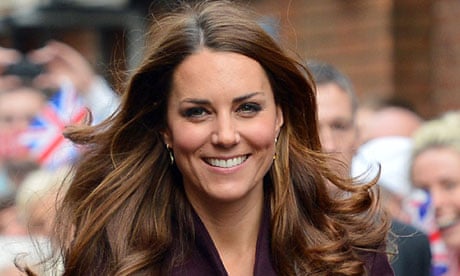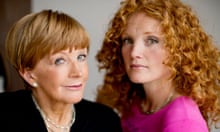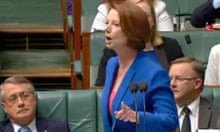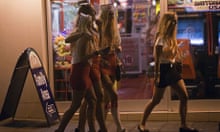Sexist stereotypes, humiliating photographs of women and male bylines dominate the front pages of British newspapers, according to research carried out by the industry body Women in Journalism (WiJ).
Male journalists wrote 78% of all front-page articles and men accounted for 84% of those mentioned or quoted in lead pieces, according to analysis of nine national newspapers, Monday to Saturday, over the course of four weeks.
The only females to be regularly pictured in the period were the Duchess of Cambridge; her sister, Pippa Middleton, and the crime victim Madeleine McCann. The three males most likely to be photographed were Simon Cowell, whose biography was published that month; Nicolas Sarkozy, who was fighting an election, and Prince William.
Women's groups, which complained about sexist stereotypes in the media in a presentation to the Leveson inquiry into media ethics, welcomed the research. Anna van Heeswijk, chief executive of Object, said: "With newspapers so male-dominated, is it any surprise that women are portrayed the way they are? Changing the number of female writers and the ways in which women are portrayed in the media is crucial if we are serious about wanting a socially responsible press."
Harriet Harman, the deputy leader of the Labour party, who has long campaigned against sexism, said: "The media is supposed to reflect the views of everybody. How much is it really reflecting the views of women in this country? In parliament, with men in the media reporting on men in parliament, there is a double whammy."
Women in Journalism's research reflects a malaise that George Entwistle, the BBC's new director general, admits is writ large in broadcasting. The BBC has faced pressure over its treatment of women on screen after a series of damaging rows over ageism and sexism involving the newsreader Moira Stuart, the former Strictly Come Dancing judge Arlene Phillips and the former Countryfile presenter Miriam O'Reilly. In recent years, figures such as Anna Ford, Selina Scott, Kate Adie, Dame Joan Bakewell and many others have spoken of their concerns about the treatment of older women by broadcasters.
Entwistle's predecessor, Mark Thompson, also admitted the broadcaster had a "case to answer" over the lack of female presenters, especially in "iconic roles". Entwistle recently went further, saying not enough had been done to promote female experts or ensure they took part in news programmes, including Radio 4's Today programme.
Entwistle said: "There's real headway with Amanda Vickery, Mary Beard and Lucy Worsley. We have made real progress in actively looking for, and finding, great female experts to front our big factual shows, but it's not enough.
"The Today programme struggles because we are dealing with party politics as it is, dealing with the world as it is, and that's a very male place. What the BBC often reflects is the way the world is."
Women in Journalism's study closely reflected research carried out by the Guardian last year, which revealed that in a typical month, 78% of newspaper articles are written by men, 72% of Question Time contributors are men and 84% of reporters and guests on Radio Four's Today programme are men.
The findings are also in line with US research by the 4th Estate earlier this year, which found that in media reports on women's issues, including abortion and birth control, men are quoted around five times more than women.
WiJ found that the most male-dominated title was the Independent newspaper, with 91% of its 70 front-page articles written by men in the period studied. In contrast, 50% of the 24 bylines leading the Express were female journalists.
Among the so-called quality press, the Financial Times had the biggest proportion – 34% – of female writers appearing on its front page. Male bylines are more prevalent at the Telegraph (89%), the Sun (86%) and the Times (82%). The Guardian had a 78% male skew.
Of the 668 people named in lead articles, 84% of those quoted or mentioned were men, most being quoted in their professional capacity. This compared with just 16% women, who were disproportionately likely to be quoted as victims and celebrities.
Although there was greater gender equality in the photographs used on front pages, there was not a single female politician or leader in the top 10 images used during the month in question.
Where powerful women were featured, the images were often unflattering. For instance, the home secretary, Theresa May, appeared as the main picture four times during the month, but three of those were the same image of her pulling her mouth down in an accentuated grimace.
The German chancellor, Angela Merkel, was pictured three times, but twice the shot was of her with her hands thrown up in the air, puffing her cheeks out. There were few pictures in which women looked powerful and serious.
In an interview after appearing before the Leveson inquiry, the singer Charlotte Church described the way women were portrayed in the UK media as despicable. It "erodes everything that women have been trying to build for years and years", she added.Object and three other women's groups, including End Violence Against Women, are monitoring the press for harmful portrayals of women – particularly victims of violence – to raise awareness of the issue during the Leveson inquiry. They are also talking separately to media regulators such as Ofcom about the issue.
Additional research by Rachel Cranshaw and Kira Cochrane.







Comments (…)
Sign in or create your Guardian account to join the discussion